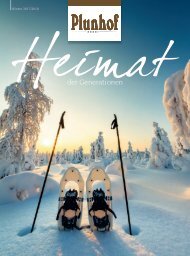Summermagazin 2015 Kronplatz Pustertal Dolomites
Image-calalog for the Holiday-Region Kronplatz | Pusteria Valley | Dolomites
Image-calalog for the Holiday-Region
Kronplatz | Pusteria Valley | Dolomites
Create successful ePaper yourself
Turn your PDF publications into a flip-book with our unique Google optimized e-Paper software.
Burger roams through the forest practically every day. In so<br />
doing, his first glance hits the ground. Is it dry or damp, fertile<br />
or infertile? Heather and lingonberries grow on dry soil. Ferns,<br />
mosses, and sorrel love water. The forest floor soaks up the rain<br />
like a sponge – up to two hundred litres can be stored for every<br />
square meter (nearly five gallons per square foot). The reason for<br />
this? The organisms that live in the soil and the roots of the trees,<br />
shrubs, and herbs that penetrate the earth create an extensively<br />
branching hollow space system. As a result of this, the rain can<br />
be quickly channelled from the surface to the depths. The roots<br />
of the trees tap into this subterranean reservoir and draw the<br />
desired moisture all the way up to the treetops. A spruce tree<br />
soaks up around forty litres (more than ten gallons) every day.<br />
Deciduous trees such as beeches and birches suck up far more:<br />
it can be up to two hundred litres (around fifty-three gallons) on<br />
hot days.<br />
Only if the rain falls in deluges would it be too much even for<br />
the forest. The spruces are the ones to lose their footing first,<br />
because their roots run flat and shallow. “Fallen trees tell me<br />
about the storms during the night,” says Burger. “Fortunately, that<br />
only happens rarely.”<br />
The precipitation in the <strong>Pustertal</strong>-Val Pusteria falls above all else<br />
in the summertime; the winters are rather dry and cold. Spruces<br />
love this climate, and they have made themselves at home in<br />
the proverbial “green valley”. At the higher elevations, they are<br />
increasingly joined by larches, and at the tree line, Pinus cembra<br />
(the stone pine) grows. It is a very particularly mix of trees that<br />
above all else is good for the health.<br />
In order to grow, trees need carbon, which they get from the<br />
carbon dioxide in the air. As a result of the plant metabolism,<br />
photosynthesis, oxygen is released. A twenty meter (sixty-six foot)<br />
spruce creates around 21,000 litres of oxygen per day – that is<br />
approximately as much as thirty-five people need daily.<br />
Scientists are enthusiastic about the positive effects that a walk<br />
in the forest carries with it: after just one hour of hiking, the<br />
blood pressure drops, the performance of the lungs increases,<br />
and the elasticity of the arteries improves. Japanese researchers<br />
have determined that those cells in the immune system which<br />
fight cancer are strengthened by a stay in the woods. What<br />
is responsible for this is likely the so-called “phytoncides” –<br />
substances which people inhale in the forest. Normally, they<br />
serve the plants as protection against pathogens and pests.<br />
And Burger also sees pests during his forest inspections. “Bark<br />
beetles cause trouble for our trees again and again, but the bugs<br />
have never caused great damage,” he says. “Our forests are<br />
very resistant because they formed naturally.”<br />
“Naturally” means that they are not clear cut and then reforested,<br />
but rather individual trees or tree groups are purposefully logged.<br />
12 | <strong>Kronplatz</strong> Summer | The Language of the Forest


















